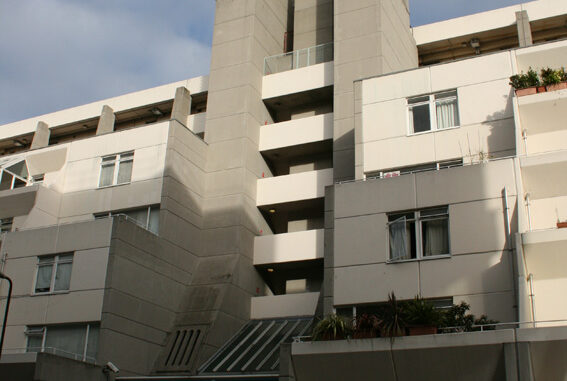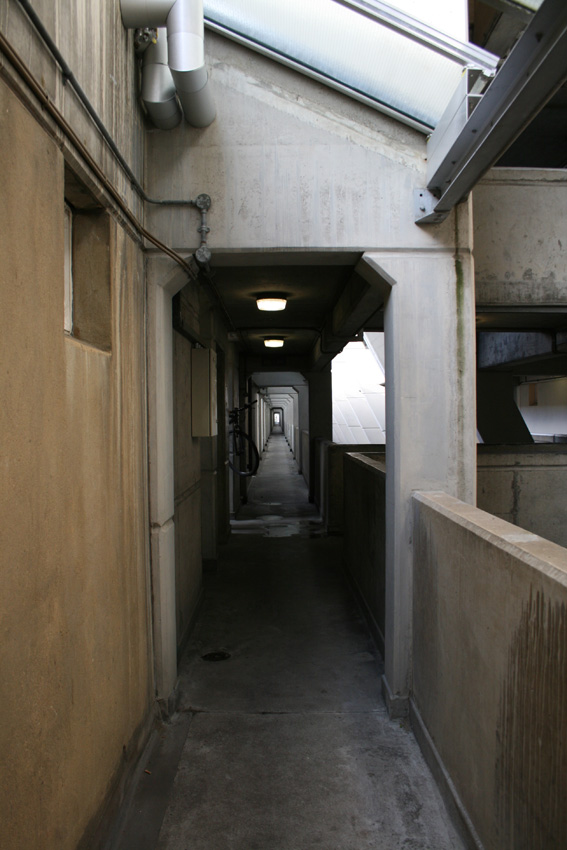
Preamble
Italo Calvino illustrates the city in Cosmicomics (1968) as a multifaceted ‘cluster of crystals’ where one must walk ‘along the edge of moldings and invisible friezes, like ants … crossing a city [to] follow itineraries traced not on the street cobbles but along walls and ceilings’. Conjuring the image of walking the smooth surface of the möbius strip where a continuous plane is traversed, on which floor turns to ceiling and ceiling to floor without ever crossing a boundary, Calvino evokes the necessity of breaking barriers within cities in order to open them up to the imagination.

This text aims to do just that – rejecting traditional modes of recounting an architectural history and adopting a metafictional take in telling the story of North London’s Brutalist building, the Brunswick. In so doing, emphasis is made on the process of writing, just as Brutalism intensifies the act of construction by revealing the mechanics behind its structure, usually with bare concrete.

New Brutalism
Post-war Britain saw the rise of the architectural movement New Brutalism, a modern aesthetic and philosophy that was embraced by London from the 1950s to 1970s as the city had been desecrated by German bombs, creating the tabula rasa the modernists wanted. The movement sprung from the era of widespread regeneration, creating a new form of architecture in Britain that rejected traditional methods of construction, which in turn influenced experimental literature preoccupied by Brutalist ideals.

The Brunswick’s Life Story
The British novelist B.S. Johnson greatly admired architectural Brutalism for its rawness and honesty. This can be found in his fiction, where exposed narratives reveal the inner mechanisms of Johnson’s text, like the Brutalist concrete structures he so admired. Using his fictional characters as a mouthpiece to say what he really thinks, Johnson’s third person narratives are a parallel to his own consciousness, which is clearly displayed in Albert Angelo (1964), the story of a struggling architect and the embodiment of the writer’s own troubles… But what happens when an author takes on the voice of a building itself? Read on and find out as this story of a Brutalist icon is told through a reversed, third to first person Johnsonian filter, offering a history of the Brunswick.
Picture this: I, the writer of this text, am The Brunswick Centre…
I am concrete, I am mega. I am called modern although I was born in ’72. People dwell within me, others ebb and flow between my spaces, interacting with the plaza and commercial units that I house. Armed with my cinema, shops and dwellings I am an architecture built for war, a city within a city, a vertical cul-de-sac allowing residents to never leave their homes. I like to think I’m attractive and I’m told I have many admirers. But, I was neglected for a long time – my face was old and filthy – my concrete weathered. I was supposedly brutal (1) yet I was a sorry soul strewn with used syringes and condoms. I feared I would be knocked down.

My father, Patrick Hodgkinson saved me (2). He fought for me for forty years and just when I thought it was all over – that I’d failed to deliver Bloomsbury the utopian dream, I became Grade II-listed (I think that means I’m special) and £25 million later after a stroke of cosmetic surgery, my face is repaired and white washed, some walkways and stairs demolished – my renaissance (almost) complete.
I know it hasn’t been easier for my brother, Trellick (3). I think it’s because we’re different and that makes it hard to be accepted sometimes. And then there’s my old comrade, Aylesbury. We’re not so dissimilar either; we are illustrations of how politics and neglect can destroy a utopian vision. Barbican’s had it easy. She’ll never know how hard it can be, what it feels like when dogs foul all over you and no-one even notices!
So, this is the story of how I began…
I was to be an architectural wonder, where beautifully light modern apartments would reside over luxury boutiques (4). But, just like Aylesbury, my costs were cutand when it was decided my core was for social housing, the elite boutiques retracted and many of my commercial units were left empty (5). Many years of waiting elapsed before I was seen in a positive light again.

Not so long ago, a man dressed up as me and stood in my square with his arms held high… Oh! Those performance artists do make me laugh. I believe his name is Arkem. He interviewed my residents and wrote a poem with their words. I remember the first stanza; it went something like this…
Brunswick Centre, quite contrary,
How does your concrete cope?
With British frosts, and spiralling costs,
And tenants who’d like to elope?
Tenants who’d like to elope? Maybe that was true in the past but I am liked a lot more now! My apartments, small as they are, go for double what they did a few years ago. Many architects and designers live in me, so I guess that means I am desirable design…

I’ve always wondered what it would be like to be in a sci-fi novel. My soaring ventilation towers could be rocket pods that jet into space as my elevated walkways hover about my space-age structure. Italian Futurist master Antonio Sant’Elia would’ve loved me! My futuristic concrete supports, like the great Gothic cathedral’s flying buttress, could have quite literally flown! My angled glasshouse apertures and stepped-back apartments would glow, quite perennially, as this novel would deal with the dystopian – a world forever shrouded in darkness. My recessed apartments open to a fire-scorched sky would rest above its basement car parking, an inferno where people are sent to burn if they weren’t 100% focused on sustaining this insular eco-mad city of slaves (an environment not too dissimilar to Atelier van Lieshout’s Slave City (6)).
Okay, maybe that’s a bit extreme… But, I am pretty extreme myself; I’ve escaped the bulldozer and gone from a shady buy-your crack-here ghetto to Grade-II listed. My journey has been tough and I’ve come a long way (7).
Notes:
1 Hodgkinson never intended his building to be labelled ‘Brutalist’ and initially wanted to whitewash the cheap concrete.
2 The Brunswick’s architect, Patrick Hodgkinson, was heavily influenced by his mentor Alvar Alto and originally wished to build the Brunswick in brick, Alto’s preferred material, but budget limitations resulted in a cheap concrete structure.
3 Ernö Goldfinger’s iconic Trellick Tower (known as the ‘Tower of Terror’ in the 1970s) was, like the Brunswick, seen as an eyesore and has experienced a similar turnaround as it is now a symbol of fashionable West London.
4 Hodgkinson was inspired by Monpazier, a medieval French town where apartments sit atop commercial spaces.
5 Great social changes were made in mid 1960s Britain as the new Labour government passed laws requiring compensation for evicted tenants. This slashed the budget for both the Brunswick and the Aylesbury Estate in South London, leaving the schemes feasibly impossible.
6 Slave City is an urban project that has been designed to maximise rationality, efficiency and profit of a city by reinterpreting contemporary ethical and aesthetic values, ideas on nutrition, environmental protection, organisation, management and markets.
7 Perhaps the Brunswick’s most iconic moment was in 1975 when Jack Nicholson appears on its concrete terraces in Michelangelo Antonioni’s film The Passenger. The wide stairs, a third of the ‘streets in the sky’, the red painted hand-rail and bench that feature in the film were still in place exactly as they were until the Centre’s recent rebirth.

I wonder what Brunswick would say about his recent face life, botox injections and so on. I rather liked his old appearance because it was honest. I though all he needed was a shave and a wash. Now all dressed in Waitrose and other high-end apparrel, I feel it’s a bit of an imposed mid-life crisis. The Brunswick’s version of going out and buying a sports car to ward off ageing. But as I said it was imposed on the dear old fellow. His half-brother, Alexandra Road, had some state-enforced plastic surgery but its insides rejected them and is now lovingly looked after and appreciated for its original features.
LD